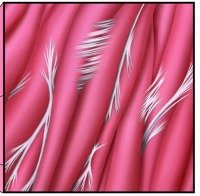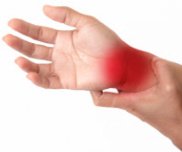Fascia
Your Key To Repetitive Strain Injury Recovery
Is your biggest question, "How do I get rid of my RSI symptoms permanently?" If so, restoring fascia to its optimum state is your answer.
What Is Fascia?
Fascia, also known as myofascia, this is the only substance in the body that is capable of creating, or contributing to, many of the symptoms you feel.
When you restore balance and proper function to this under-appreciated tissue, your body has the ability to heal itself of your injury, safely, naturally, and non-invasively.
Like a cobweb that runs through your entire body, this form of connective tissue provides support for organs, blood vessels and nerves. It transmits the contraction of muscle fibers to the bones they move. It forms the container for all the structures under your skin. Its interconnected nature means that by way of the matrix, everything in your body is connected to everything else.
Fascia Transmits Movement

When a muscle contracts, the contractions generate a pull through the matrix, affecting all other parts of your body. When you have chronic contraction of the muscles in your low back, the strain is transmitted through the rest of your back and into the neck, arms and legs.
When the forearm muscles experience constant strain from an activity like gripping a tool, that strain goes up into the armpits, shoulders and neck. Everything is connected to everything through the fascial matrix.
Fascia Creates a Sliding and Gliding Environment
Fluidity allows the muscles, nerves and blood vessels to slide and glide through, next to, and across one another. Because of this, it is essential that fascia be properly hydrated. When it dries out or becomes even a little less fluid, it tends to create a drag on the structures it supports. Sliding and gliding of nerves and blood vessels becomes limited. Muscles become tethered to one another which makes it harder for each of them to contract fully. The end result is those muscles begin to feel weak when, in fact, they are only stuck to a neighbor.
Fascia Contributes to Repetitive Strain Injuries
When changes in the consistency of the connective tissues occur in your hands, arms, neck, shoulders and upper torso, they often lead to the symptoms you feel as a repetitive strain injury. No matter what other modality, procedure or technique you add to your healing process, you will always have to address the changes to the connective tissue matrix in your body in order to get the best possible results and the highest level of healing.
• Your Body Has A History
Your body has a history. Your history includes past injuries, poor posture, work habits, stress, accidents, surgeries, and other traumas. Fascia responds to all these conditions by undergoing a chemical change. And those changes can lead to pain and dysfunction.
• Changes Chemically
When subjected to stress, strain, traumas and other unnatural forces, your connective tissues detect this strain and attempt to help support the body through the strain. To do so, it begins to change chemically. Bonds begin to form between the collagen fibers that are abundant in this tissue. This thickens its consistency and creates the perfect environment for adhesions to form.
In a way, this can be seen as a very helpful self-protective characteristic. The body is trying to prolong the continued movement, muscle contractions and physical support of the body. Even though your body may be compromised by poor posture, bad habits, injuries and other trauma, fascia has a built-in mechanism to add support, like adding an additional brace to a wobbly brick wall. Under normal circumstances, this will allow the body to continue to operate for a good long while, until, eventually, the number of adhesions and the extent they spread throughout the body reaches a critical level. When you reach that level, which is individual for each person, you begin to feel symptoms of your injury.
• Responds To Stresses Of All Kinds
Stress can come from chronic overuse like constantly typing on a keyboard for hours each day, impact trauma like a fall or a whiplash injury, surgery or other cutting, broken bones, emotional stress, etc. Yes, even your stressful daily commute may be contributing to your injury.
Poor habits like bad posture can generate problems with your connective tissues. After all, gravity is a force that either supports a body when it's in proper balance, or it can tear a body down when it's out of balance, as in poor posture.
Holding parts of your body very still can also be a significant source of strain. This is why your body feels stiff and unable to move properly when a cast is removed. The fascia has not had the chance to move for a long time has become tighter, shorter and stickier because of the immobility.
When fascia is subjected to the stresses of life, whether physical, mental or emotional, it starts to get sticky. It thickens. It becomes less moveable. It prevents muscles from contracting fully, or it locks them in a semi-contracted state as you would see in a body builder who has clearly defined muscles even when he is not trying to contract them.
The result? Pain. Weakness. Numbness. Tingling. Limited range of motion.
• Forms Adhesions

Adhesions are places where one layer of tissue adheres to another. An example would be two muscles that are designed to slide and glide across one another becoming tethered to one another because a chemical bond has formed between them. In this case, every time one of the muscles contracts, it has to drag the other one along. This causes fatigue and a feeling of weakness. Normal range of motion becomes limited in each affected muscle or muscle group.
The fascia surrounding nerves and blood vessels can also become sticky. So, instead of the nerves and blood vessels sliding effortlessly alongside neighboring muscles, they become stuck to them. Now, every time the muscle contracts, it drags the nerve or blood vessel along, causing irritation and an increased thickening of the fascia meant to protect those sensitive structures. Nerve related symptoms begin to develop from all the unnecessary irritation. Blood vessels can become squeezed inside a tightening sleeve of fascia.
• Adhesions Can Spread
The changes that develop in the matrix tend to spread and affect more and more of the body as they become more established. Once tissue becomes glued to its neighbor, additional strain is generated, leading to the need for more support. More and larger adhesions form in order to bolster the body in its compromised condition.
Constantly looking down at a phone or other electronic device creates a shortening of the connective tissues and muscles at the front of the neck and torso. Over time, because of the effects of gravity, symptoms will begin to generate in the low back and upper shoulders. Extending your arms forward to type on a keyboard can put excessive strain on the tendons at the elbow, with strain extending up into the armpits, shoulders and upper back and down into the forearm. Everything is connected to everything!
How Do You Get Fascia To Return To A More Normal State?
|
Watch this fascinating clip showing fascia releasing as it is being stretched and tendon sliding through its protective sheath. |
This unique tissue has the ability to be restored to its non-binding, fluid state through stretching. This can be manual stretching done in a therapeutic setting by a trained therapist, or it can be through appropriate stretching that you can do on your own.
In this website, you will find what you need to know to restore your fascia to a more normal state through our program of stretching self care. Once it returns to being the loose, slippery and supportive tissue it was meant to be, your body will heal the effects of strain and injury on its own.
To learn even more about fascia, click on the links below.
Fascia Anatomy - Understanding Your Opponent
Adhesions - The Real Source of Your Injury
Scar Tissue - Previous Injuries Add To Your Pain
Stretching Fascia - The Ultimate Injury Solution
Fascia and Nerves - How Fascia Can Affect Nerve Functioning
Click the block below that most closely matches your injury for more information and to find the Toolkit we offer to help you in your recovery.







